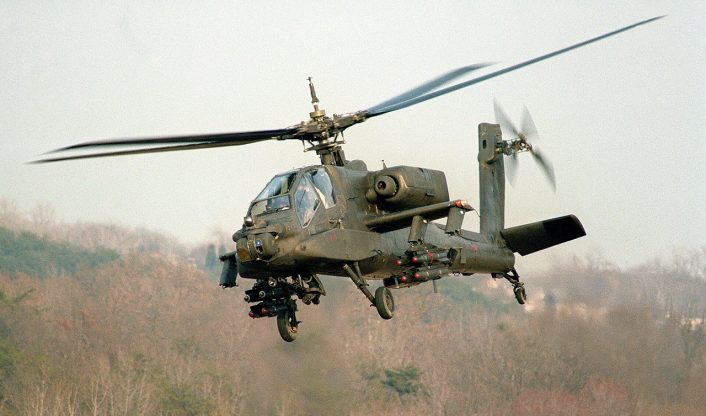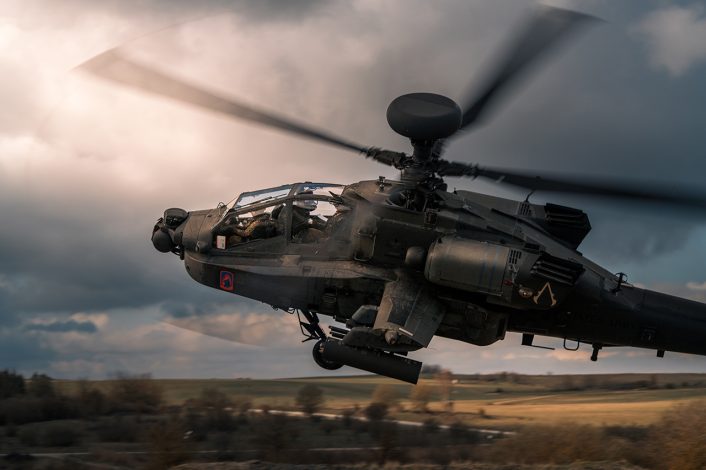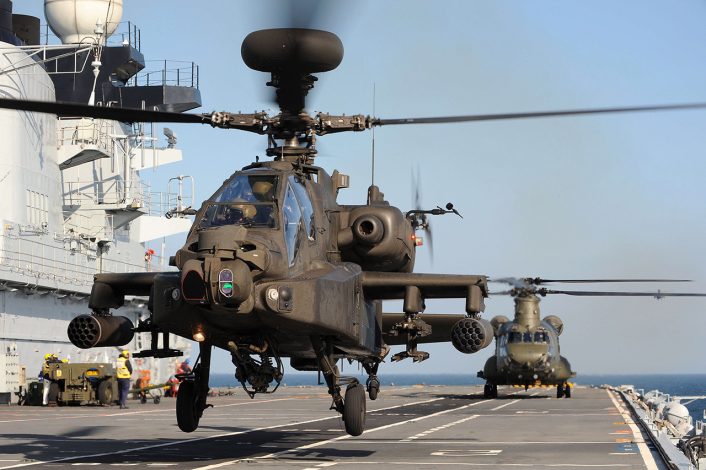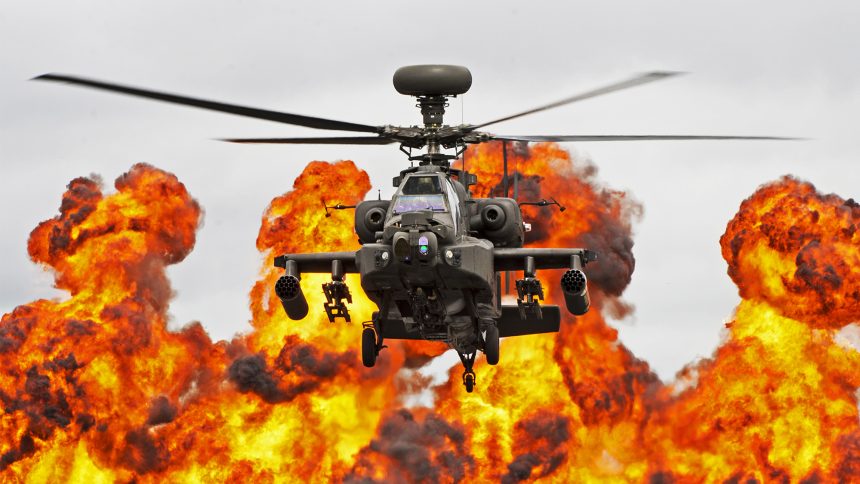Sept. 30, 2025 marks 50 years since the first YAH-64A prototype took to the skies for the first time. Let’s look at how the Apache has maintained its sharp edge over those five decades.
Born from the Advanced Attack Helicopter (AAH) program, the YAH-64 was originally designed by Hughes Helicopters, and faced down with Bell’s YAH-63 in the final stage of the competition. Though innately a more conservative design compared to the Lockheed AH-56 Cheyenne compound helicopter, which was cancelled in favor of the AAH program, the YAH-64 made use of newer design techniques which increased survivability, including composite materials that allowed the helicopter’s four rotor blades to survive multiple hits from 23 mm high-explosive incendiary ammunition. The YAH-64 was selected as the AAH program winner in 1976.
Christened as the Apache in 1981, full rate production was approved the following year and the first production example was unveiled in 1983. In 1984, Hughes was purchased by and folded into McDonnell Douglas, who then oversaw ongoing production as well as upgrades. Incremental upgrades through the 1980s were set aside in favor of a major capability enhancement with the AH-64D model, first flying in 1992. The first production AH-64D would then be delivered five years later.

As well as an array of electronic and mechanical updates throughout the aircraft, the most noticeable change with the AH-64D was the introduction of the famous rotor hub mounted AN/APG-78 Longbow millimeter-wave fire control radar which offered simultaneous tracking of up to 128 targets and active targeting of 16 at any one time. The D model would continue to receive in-service upgrades throughout its service life, which continues to this day. The last AH-64A bowed out of U.S. service in 2012, the last airframes being earmarked like many before for remanufacture into AH-64D standard.
From McDonnell Douglas’ merger into Boeing in 1997, the Apache thereafter became a Boeing product.

Export orders for the AH-64A were already fairly strong, with Israel, Greece, Saudi Arabia, Egypt, and the United Arab Emirates all purchasing the initial model Apache. 937 in total were delivered, the vast majority to the U.S. Army. The AH-64D sped up orders even more, with over 1,000 deliveries made between 1997 and 2013 – including new-build and remanufactured aircraft. The most notable new customer was arguably the United Kingdom, who chose the AH-64D over fierce competition from the Eurocopter Tiger, Bell AH-1 Super Cobra, Agusta A129 Mangusta, and RAH-66 Comanche.
The Army Air Corps 67 AH-64Ds would be licence built by AgustaWestland with the internal designation WAH-64D. A number of changes were made to adapt the Apache to the UK market, including the adoption of more powerful Rolls-Royce Turbomeca RTM322 engines which would later prove crucial when operating in Middle Eastern climates. A folding main rotor was also incorporated to allow seamless integration of British Apaches into shipborne helicopter air wings.

Apache Guardian
Arriving with customers almost 20 years after the AH-64D’s first flight, the AH-64E Apache Guardian is another radical overhaul of the Apache design. Though from the exterior appearing mostly unchanged, the internals have been upgraded to a much more modern standard with more powerful engines, modern avionics with new communications capabilities, and a new rotor blade design. Many of the in-service upgrades added as extras onto the AH-64D throughout its life have made it into the AH-64E’s default specifications.
The Longbow mast radar remains in an upgraded form, though it can also be replaced entirely in favor of a new module designed to exploit Manned-Unmanned Teaming (MUM-T) tactics and allowing the AH-64E crew to directly take control of UAVs and their weapons. The widely used Link 16 datalink standard has also been incorporated on the AH-64E, offering direct and secure communications and targeting integration with a wide range of other aircraft and platforms.

Many existing Apache operators opted to procure the AH-64E, and a number of new nations also joined the Apache family. This includes India, Australia, Morocco, Poland, and others. While the conflict in Ukraine has raised questions regarding the ongoing utility of traditional attack helicopters like the Apache, new technological developments with the airframe mean that while its role has evolved, it still has a part to play in modern warfare.
The Apache’s extensive and versatile weapons capability mean it is a very flexible platform. Along with the 30 mm nose-mounted chain gun, the Apache’s wing stations can carry guided missiles, rockets, fuel tanks, and even air to air weapons. Initially developed side-by-side with the Hellfire missile, the Apache today can also fire the AGM-179 Joint Air-to-Ground Missile, Brimstone, and Spike NLOS guided missiles. Unguided rocket pods now have the capability to deliver guided Advanced Precision Kill Weapon System (APKWS) equipped rockets. As well as offering a lighter option against some ground targets, with a higher total payload, the counter-drone capabilities of APKWS mean Apaches can also be deployed in a defensive role against UAVs and one-way attack munitions.
What’s it like to operate the world’s most advanced attack helicopter?
1LT Rosie Price describes how the @USArmy utilizes the “latest and greatest” AH-64E v6 Apache — from receiving video from UAVs to harnessing the full power of upgraded engines.
#ParisAirShow #AH64 pic.twitter.com/f9kYoo9yHR
— Boeing Defense (@BoeingDefense) June 22, 2023
In the near future, canister-launched UAVs could be integrated onto the AH-64E’s weapon stations and coordinated by the aircraft’s ‘gunner’ in addition to externally deployed UAVs to significantly widen the aircraft’s intelligence, surveillance, and reconnaissance (ISR) footprint. A fairly significant number of UAVs could be carried even without a major sacrifice to the Apache’s weapons payload.
With the potential to serve into the 2060s, the Apache is sure to continue to see dramatic evolutions in form and function. Assuming the design is replaced by a new family of aircraft, or another capability entirely, from the 2060s, the Apache airframe would bow out as a 90-year old design. This remarkable fact, the rough equivalent to a Hawker Hurricane variant serving today as a frontline fighter aircraft, is testament to the longevity of Hughes Helicopters’ original design and the subsequent work to keep the Apache at the top of its game.









